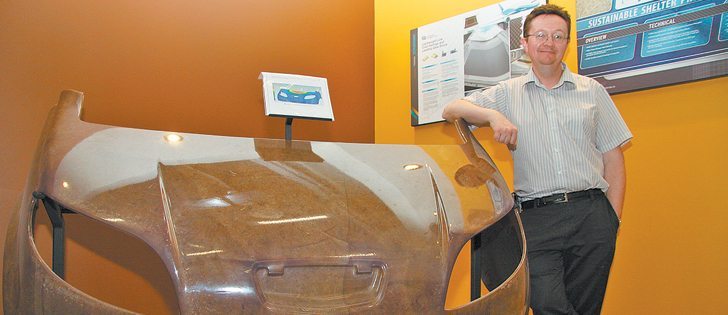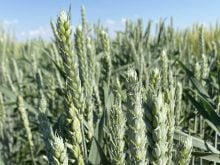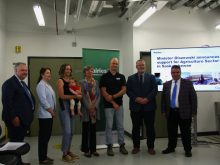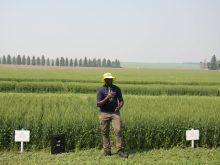Exterior automobile parts | Researchers study composite made from hemp, agave and other fibres
Automobile makers have touted their green credentials for the last few years, using words like “sustainability” in nearly every television ad and turning trademarks like EcoBoost into household names.
Besides manufacturing more efficient engines, automakers are also greening their vehicles by using biomaterials for minor components, such as storage compartments made from wheat straw.
However, a Calgary company and western Canadian research institutes are working on something slightly more ambitious — a car with a body made entirely from hemp, flax and other biofibres.
Motive Industries, a vehicle design firm, is developing the Kestrel, a four passenger electric vehicle that is expected to weigh 850 kilograms, reach a top speed of 135 km-h and have a range of 160 kilometres.
Read Also

Gene editing digs deeper space in Canadian plant breeding
More Canadian research into crop variety development is incorporating gene editing, and one researcher notes that Canada’s regulatory approach to gene editing will help drive innovation
Using natural fibres for its body instead of steel or fibreglass reduces the Kestrel’s weight and improves its efficiency, said Nathan Armstrong, Motive Industries president.
As well, using biomaterials helps support Canadian industry and suppliers, including hemp growers.
“Response to this innovative vehicle design … has been phenomenal,” said Armstrong in a statement.
“We get hundreds of calls from potential industry partners and media as far away as India.”
The company is relying on Canadian biomaterial scientists to work out the technical details of building a car from hemp fibres.
One of those experts is Simon Potter of the Composites Innovation Centre (CIC) in Winnipeg.
Potter, who spoke March 22 at the Manitoba Rural Adaptation Council (MRAC) annual meeting in Portage la Prairie, Man., said CIC experts are developing formulations of biofibres and resins that will satisfy safety guidelines for automobiles.
“We’re working together to test out the suitability of the (natural) materials for the particular components they have in mind. It looks very pro-mising,” said Potter, who thanked MRAC for supporting CIC’s research on the Kestrel project.
“If you do a search on biocomposites in the auto industry, you’ll see a lot out there. The difference is what we’re doing here, from the rest of the world, is the rest of the world is doing non-structural (components)…. We’re actually targeting the structural components of the vehicle … the exterior.”
Scientists at the CIC lab are testing the strength and flexibility of biocomposites to ensure that natural fibres like hemp are suitable for the Kestrel’s exterior, including bumpers, roof and panels.
One of the unique features of biocomposites is the material’s ability to retain its shape. Metal will bend or crumple when force is applied, but Potter said biocomposites will bounce back to their original shape.
CIC researchers have developed a composite made from hemp, agave and other fibres. The natural fibres aren’t as strong as plexiglass, so glass fibres are used to make the biocomposites stronger.
“The worst thing we can do is wait for the perfect material for every application. Let’s just get it in there, with what we’ve got right now.”
Researchers are working on developing natural resins to bond with the hemp fibres, which should improve the material’s strength.
The composite industry is worth about $500 billion annually worldwide, which means it could become a multibillion-dollar industry in Canada if biocomposites made from prairie crops can grab a fraction of the demand from auto, aerospace and other industries, he said.
Fiber-Werx of Sylvan Lake, Alta., is producing moulds for the Kestrel’s exterior based on CIC research.
Alberta Innovates Technology Futures (AITF) has also contributed to the Kestrel’s body, focusing on all aspects of the hemp value chain from crop production to biocomposite development.
“We did a lot of the early work in terms of trying to develop the hemp backbone structure for the composites,” said John Wolodko, AITF ad-vanced materials manager.
“Some of the early prototypes were derived from our crops in Vegreville, (Alta.).”
CIC’s work on biocomposites has caught the eye of major players in the auto industry. Potter recently met with representatives of Ford and Hyundai, and both companies expressed interest in CIC’s technology.
For instance, one potential use of a biocomposite material could be the wheel arch on the Hyundai Sonata, Potter said. If that happens, it would take 750 tonnes of hemp to make the wheel arches for the popular vehicle.
If Hyundai decided to use the hemp-based material for the wheel arches on all of its vehicles, the demand for hemp would expand exponentially, he added.
Carmakers elsewhere are also using renewable materials. The European Union has legislation requiring 20 percent renewable content on all new vehicles, Potter said, creating demand for biomaterials.
“Similar legislation will come here eventually,” he said. “Companies like Ford have the forward thinking to say we’re going to get ahead of that curve.”
Motive Industries did not return phone calls for this story by press time, so it’s not clear when the Kestrel will be available to buy in Canada.
















